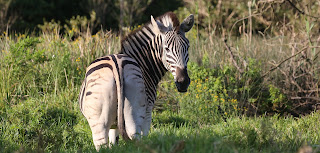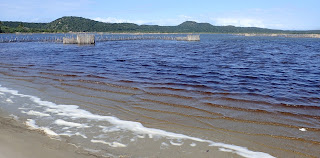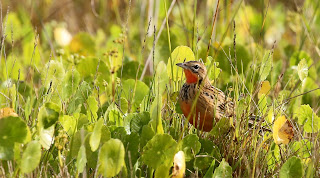Isandlwana Hill in the present day.
We left the coast on 26th May for a two nights stay at the Rorke's Drift Lodge. It was an horrendous journey, filled with major roadworks & so many hills to climb in the Landcruiser pulling a trailer! The last 5kms was also on a narrow, twisting track. We arrived late afternoon & met our hosts, one of which would be our guide the next day.
Dawn, looking from the lodge towards
the battlefield site.
Normally this kind of subject matter would not make it on to my blog but me being British & Delana South African, it is part of our joint history. I think the very first movie in color I saw, was Zulu with my parents in the old cinema in Thorne in South Yorkshire. It made a big impact on me & I always wanted to visit the actual battlefield location. So when we both realized that it was virtually on our way back from the coast to Pretoria we took advantaged of a covid special, two nights stay at Rourke's Drift Lodge, complete with evening meals & a tour of the battlefield site. So here we were & it proved to be an excellent experience.
Setting the scene, looking over the entire area. Our terrific guide Peter explaining how the action unfolded.
The battles of Isandlwana & Rouke's Drift were the first significant battles on the Anglo-Zulu War. They took place over January 22nd & 23rd 1879. Although the two battles can be considered as a continuation of the first encounter. In December 1878 the British Government gave the Zulu King an ultimatum, which was designed to be impossible to comply with.
Buffalo River, which marked the boundary between
Natal & the Zululand Kingdom.
Consequently Lord Chelmsford in command of three columns, crossed the Buffalo River into Zululand in early January 1879. He established a depot at Rorke's Drift. He then moved cautiously eastwards further into Zululand. The Zulu King's policy was to withdraw his troops & try & avoid direct confrontation. He hoped to negotiate & in particular, he forbade his troops from retaliating by entering Natal.
Isandlwana may be seen in the distance.
Notice how the topography is undulating, which was to play a major part in the
outcome of this battle.
On January 22nd Chelmsford left around 2,000 men around the hill at Isandlwana. They were unlaggered, which meant they had no defensive fortification around them at all. Around 20,000 Zulus attacked & caught the British troops out in the open & around 1,300 men were massacred. This was the first time a British Army had been defeated by native troops.
The battlefield is protected today.
The monument to the British troops, which fell that day.
The rather more modern & tasteful, Zulu memorial.
Rorke's Drift.
Before the British Army took it over it was a trading post for the region.
Later that same day a second Zulu force, numbering around 5,000 men, attacked Rourke's Drift outpost which was defended by around 120 British troops. The defenders had been forewarned of the impending battle, by the few survivors of the battle at Isandlwana, so had time to make defensive preparations. The battle lasted over 12 hours throughout the night & was at times, intense hand to hand combat. At the end of the battle over 500 Zulu troops were killed & only 17 British troops lost their lives.
Today, the old depot has been restored & hosts a small museum.
The culmination of a long held boyhood dream!
Eleven Victoria Cross Medals were awarded to the defending British troops, (the highest awarded in any one single battle, in British Army history). Paradoxically this Zulu victory at Isandlwana brought about the Zulu Kings downfall, as once the terrible news reached British shores, the government sort to gain revenge & recover their prestige in the region.
The lounge in the nicely appointed chalet.
It was a terrific day out & Peter brought the whole epic battle (s) to life more than one hundred years later. The lodge is an excellent place to stay & one could use it as a base for further exploration of this region. An area of South Africa which I only know from the history books, but would love to explore further in the future. Delana & I then set out on the long drive back to Pretoria.





































































































